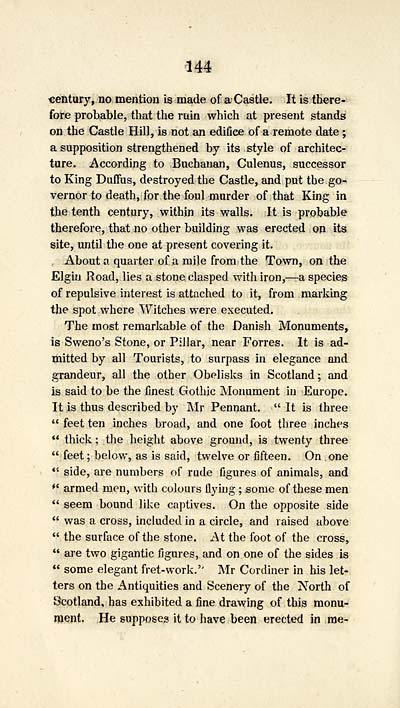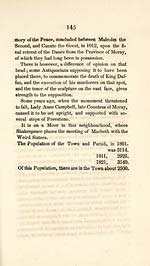Descriptive account of the principal towns in Scotland
(166) Page 144
Download files
Complete book:
Individual page:
Thumbnail gallery: Grid view | List view

144
century , no mention is made of a Castle. It is there-
fore probable, that the ruin which at present stands
on the Castle Hill, is not an edifice of a remote date j
a supposition strengthened by its style of architec-
ture. According to Buchanan, Culenus, successor
to King Duffus, destroyed the Castle, and put the go-
vernor to death, for the foul murder of that King in
the tenth century, within its walls. It is probable
therefore, that no other building was erected on its
site, until the one at present covering it.
About a quarter of a mile from the Town, on the
Elgin Road, lies a stone clasped with iron,— a species
of repulsive interest is attached to it, from marking
the spot where Witches were executed.
The most remarkable of the Danish Monuments,
is Sweno's Stone, or Pillar, near Forres. It is ad-
mitted by all Tourists, to surpass in elegance and
grandeur, all the other Obelisks in Scotland; and
is said to be the finest Gothic Monument in Europe.
It is thus described by Mr Pennant. "It is three
"feet ten inches broad, and one foot three inches
*' thick ; the height above ground, is twenty three
" feet ; below, as is said, twelve or fifteen. On one
" side, are numbers of rude figures of animals, and
ft armed men, with colours flying ; some of these men
" seem bound like captives. On the opposite side
" was a cross, included in a circle, and raised above
" the surface of the stone. At the foot of the cross,
" are two gigantic figures, and on one of the sides is
" some elegant fret- work.'' Mr Cordiner in his let-
ters on the Antiquities and Scenery of the North of
Scotland, has exhibited a fine drawing of this monu-
ment. He supposes it to have been erected in me-
century , no mention is made of a Castle. It is there-
fore probable, that the ruin which at present stands
on the Castle Hill, is not an edifice of a remote date j
a supposition strengthened by its style of architec-
ture. According to Buchanan, Culenus, successor
to King Duffus, destroyed the Castle, and put the go-
vernor to death, for the foul murder of that King in
the tenth century, within its walls. It is probable
therefore, that no other building was erected on its
site, until the one at present covering it.
About a quarter of a mile from the Town, on the
Elgin Road, lies a stone clasped with iron,— a species
of repulsive interest is attached to it, from marking
the spot where Witches were executed.
The most remarkable of the Danish Monuments,
is Sweno's Stone, or Pillar, near Forres. It is ad-
mitted by all Tourists, to surpass in elegance and
grandeur, all the other Obelisks in Scotland; and
is said to be the finest Gothic Monument in Europe.
It is thus described by Mr Pennant. "It is three
"feet ten inches broad, and one foot three inches
*' thick ; the height above ground, is twenty three
" feet ; below, as is said, twelve or fifteen. On one
" side, are numbers of rude figures of animals, and
ft armed men, with colours flying ; some of these men
" seem bound like captives. On the opposite side
" was a cross, included in a circle, and raised above
" the surface of the stone. At the foot of the cross,
" are two gigantic figures, and on one of the sides is
" some elegant fret- work.'' Mr Cordiner in his let-
ters on the Antiquities and Scenery of the North of
Scotland, has exhibited a fine drawing of this monu-
ment. He supposes it to have been erected in me-
Set display mode to: Large image | Transcription
Images and transcriptions on this page, including medium image downloads, may be used under the Creative Commons Attribution 4.0 International Licence unless otherwise stated. ![]()
| Gazetteers of Scotland, 1803-1901 > Descriptive account of the principal towns in Scotland > (166) Page 144 |
|---|
| Permanent URL | https://digital.nls.uk/97352697 |
|---|

